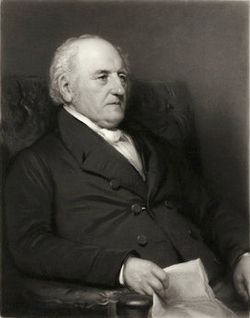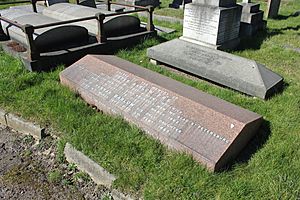Peter Barlow (mathematician) facts for kids
Quick facts for kids
Peter Barlow
|
|
|---|---|

Peter Barlow
|
|
| Born | 13 October 1776 Norwich, Norfolk
|
| Died | 1 March 1862 (aged 85) |
| Nationality | English |
| Known for | Barlow lens Barlow's wheel Barlow's formula Barlow's Tables |
| Awards | Copley Medal (1825) |
| Scientific career | |
| Fields | Mathematics, physics, engineering |
Peter Barlow was an English mathematician and physicist. He was born on October 13, 1776, and passed away on March 1, 1862. He made many important discoveries in math, physics, and engineering during his lifetime.
Contents
Peter Barlow's Work in Mathematics
Peter Barlow started working at the Royal Military Academy, Woolwich in 1801. He taught mathematics there for many years, until 1847. He wrote articles about math for different publications, including The Ladies' Diary.
He also wrote several books, such as:
- An Elementary Investigation of the Theory of Numbers (1811)
- A New Mathematical and Philosophical Dictionary (1814)
- New Mathematical Tables (1814)
His book New Mathematical Tables became very famous and was known as Barlow's Tables. This book contained lists of squares, cubes, square roots, cube roots, and other calculations for numbers from 1 to 10,000. These tables were very useful for scientists and engineers for a long time. They were printed regularly until 1965, when computers made them less necessary. Barlow also wrote articles for other large encyclopedias, like Rees's Cyclopædia and Encyclopædia Metropolitana.
Discoveries in Physics and Engineering
Peter Barlow worked with an optician named George Dollond between 1827 and 1832. Together, they created a special type of achromatic lens. This lens used liquid carbon disulfide to help correct colors. Achromatic lenses are very important parts of telescopes because they help make images clearer. In 1833, Barlow made another type of achromatic lens using two different kinds of glass. A version of this design, called a Barlow lens, is still used today in astronomy and photography. It helps to increase both the magnification and color correction of images.
Magnetic Research and Inventions
In 1823, Peter Barlow became a member of the Royal Society, a famous group of scientists. Two years later, he won the Copley Medal. This award was for his work on fixing problems with ship compasses. The iron in a ship's hull (the body of the ship) could make the compass give wrong readings. Barlow found a way to correct this. He also studied terrestrial magnetism, which is the Earth's natural magnetic field.
Barlow is also known for inventing the Barlow's wheel. This was an early type of homopolar motor, which is a simple electric motor. He also developed Barlow's law, which was a formula about how electricity moves through materials, though it was later found to be incorrect.
Early Telegraph and Railways
In 1820, another scientist named André-Marie Ampère suggested that an electromagnetic telegraph could be made. This would work by using an electric current to move a compass needle. Peter Barlow looked into this idea in 1824. He thought it wouldn't work well because the effect on the compass became much weaker with only 200 feet of wire. Because of this, some people say Barlow and other scientists slowed down the development of the telegraph. However, Ampère's original design didn't use a special coil around the compass, which would have made the signal stronger over distance.
Barlow was also very interested in steam trains. He served on several railway commissions between 1836 and 1845. He also helped the new Railway Inspectorate by doing investigations in the early 1840s.
Contributions to Materials Science
Barlow made important contributions to understanding the strength of materials. This is about how strong different materials are and how much force they can handle. One of his important works was Essay on the strength and stress of timber (1817). This book included data he collected from experiments. After he passed away, his two sons updated this book and included a story about their father's life.
Barlow also used his knowledge of materials to help design bridges. His sons, Peter W. Barlow and William Henry Barlow, both became famous civil engineers in the 1800s. In 1832, Peter Barlow was made an honorary member of the American Academy of Arts and Sciences.
Peter Barlow passed away in 1862 at his home in Charlton. He was buried in Charlton Cemetery.
See also
 In Spanish: Peter Barlow para niños
In Spanish: Peter Barlow para niños
- 2147483647, Barlow commented on this Mersenne prime



